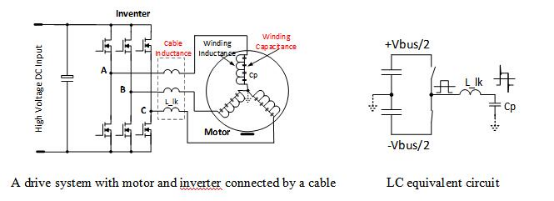Variable Frequency Drive (VFD) has been widely used in industrial and automotive areas. The key technology is high frequency pulse width modulation (PWM) by using semiconductor switches. Mainly two-level inverters operating at switching frequencie...
Share
Variable Frequency Drive (VFD) has been widely used in industrial and automotive areas. The key technology is high frequency pulse width modulation (PWM) by using semiconductor switches. Mainly two-level inverters operating at switching frequencies in the range of 4 to 16 kHz generate three-phase sinusoidal fundamental voltages or currents to drive motors. For 400V and above bus voltage, IGBTs dominate the application. With the emergence of wide-bandgape SiC MOSFETs, the devices’ superior switching performance quickly attracts great attention on motor drive development. A SiC MOSFET is able to reduce switching loss by around 70% of its counterpart Si IGBTs or achieve the same efficiency at near 3x switching frequency. SiC MOSFETs, behaving like a resistor, lack of IGBTs’ PN junction voltage drop, which reduces conduction loss, especially at light loads. With higher PWM frequencies and higher motor drive’s fundamental frequencies achievable, a motor can be designed with a larger pole number to reduce the motor size. An 8-pole motor can reduce size by 40% of a 2-pole motor with the same output power. High switching frequency enables high density motor design. These performances show a great potential of SiC MOSFETs on high-speed, high efficiency and highdensity motor drive applications. The successful application of SiC MOSFETs on Tesla Model 3 marked the beginning of the SiC-based motor drive era. The tendency is strong that SiC MOSFETs would dominate automotive traction applications, especially on 800V battery vehicles and gain more share on industrial high-end applications.
To fully exploit the benefit of SiC MOSFETs, switching speed (dv/dt) and switching frequency should be raised by one order of magnitude or more from current IGBT-based solutions. Despite of the great potential of SiC MOSFETs, the devices’ application is still limited by current motor technology and drive system structure. Most motors have high winding inductance and large parasitic capacitance. A three-phase cable connecting a motor to an inverter essentially forms a LC circuit, as shown below. The high dv/dt voltage at the inverter output can excite the LC circuit and the voltage spike at motor terminals could ring as much as twice of the inverter output voltage. It adds significant voltage stress on the motor windings.

When the inverter is directly attached to the motor, cable voltage ringing doesn’t exist anymore. However, the high dv/dt voltage change would be applied to the windings directly as depicted below, which can accelerate winding aging. Furthermore, the high dv/dt voltage can induce a bearing current and cause bearing erosion and premature failure.

Another potential issue is EMI. High dv/dt and high di/dt can induce higher electromagnetic interference emission. All designs need to take account of these effects for both IGBT and SiC based solutions.
To mitigate these issues, different techniques have been developed. If a motor and an inverter driver have to be separated, a dv/dt edge filter or sinusoidal filter is an effective solution, but with some cost added. Motor design itself has been improving since IGBT inverters became commercially available. With better insulated magnetic wires and improved motor coil winding structure and shielding methods, motors’ dv/dt handling capability has been improved substantially from a few V/ns initially and it will eventually reach the goal of 40-50V/ns. SiC-based inverters are very efficient with efficiency usually reaching 98.5% at 40kHz and 99% at 20kHz. Due to the driver loss, integrated motor drive becomes feasible and an attractive system solution, which eliminates all cables and terminal connections and reduces system size and cost. Fully enclosed inverter driver and motor is an effective way to reduce EMI emission. Bearing current can be bypassed by shorting the motor’s shaft to stator with a grounded spring or brush. Compact highly-efficient, low-weight and integrated motor drives are widely used in industrial robots, airborne and underwater drones, etc
Besides drive system size reduction, SiC MOSFETs enable high speed drive as well. High speed drives have gained a growing interest in automotive, aerospace, spindles, pump and compressors. High speed drives have become state of the art for some of the aforementioned application while in some niche application, the adopting of high speed drives has enhanced the performances and the capabilities in terms of product quality and product innovation.

Integrated Drive Applications
To provide a smooth sinusoidal drive, the VFD switching frequency needs to be at least 50 times higher than ac current frequency. Therefore, Switching frequency, pole pair and motor speed has the following relationship:
f_PWM = 50∙ Pole-Pair ∙ rpm /60
Namely, for a common 4-pole motor, to reach 10 krpm, f_PWM needs to be 16.6kHz, which is about the maximum IGBT switching frequency. Therefore, for any motor speed over 10 krpm, SiC MOSFETs become a preferred or only valid option. To increase motor power density, pole-pair number is usually increased, which requires an even higher PWM switching frequency. The application of SiC would propel a new round’s motor design improvement and innovation.